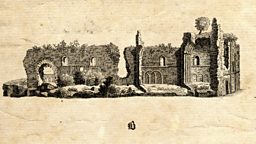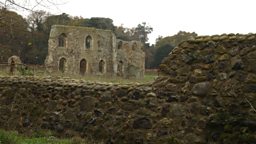Dunwich - a destination point for Shakespeare's players
Shakespeare’s company The King’s Men visited this relatively small harbour town on the Suffolk coast no less than three times while Shakespeare himself was with the company - between 1606 and 1611. They also visited in 1614-15, the year after he had retired.
The three visits by Shakespeare’s troupe - when he was with the company - occurred when he was at the very summit of his creative production.
-
![]()
Much ado near me
Hear more Shakespeare stories on BBC Radio Suffolk
-
![]()
Shakespeare Festival 2016
The BBC celebrates the genius of the bard

Shakespeare had written the four great tragedies and was now turning to romance as his chosen form. Antony and Cleopatra, Coriolanus, Timon of Athens and Pericles all came into print in 1607-8. Cymbeline, The Winter’s Tale and The Tempest are dated between 1609 and 1611. Although there is no evidence to confirm that Shakespeare came to Dunwich with his company, equally no argument presents itself that he did not.
The three visits by Shakespeare’s troupe - when he was with the company - occurred when he was at the very summit of his creative production.
The troupe certainly had access to the entire canon of his works, and the people of Dunwich were more privileged than they knew, to see at least one of those plays.
Indeed, why did Shakespeare’s men chose to perform in such a remote part of England? For centuries, the ill-fated town had fought against the relentless onslaught of the North Sea. Such that by 1740, what was once a substantial town and a large, ancient port with a major fishing industry, had been reduced to a small hamlet - its many substantial buildings lying beneath the encroaching waves.
But in Shakespeare’s time, in spite of the centuries of ceaseless erosion, it was still a thriving borough with a civic charter dating from King John - and a minor, but lucrative, port. Professional acting companies, including Shakespeare’s own troupe, still found reason to stop there to perform.
The King’s Men visited Dunwich after Shakespeare’s death in 1633-4, during the reign of Charles I. In that year they also stopped at Ipswich and Aldeburgh, so it appears that they were following a route that took them south to north through coastal Suffolk. In 1610, when Shakespeare’s company visited Dunwich, they stopped at Sudbury, which creates the impression that they might have been following the same coastal route as in 1634.
Shakespeare on Tour
From the moment they were written through to the present day, Shakespeare’s plays have continued to enthral and inspire audiences. They’ve been performed in venues big and small – including inns, private houses and emerging provincial theatres.

BBC English Regions is building a digital picture which tracks some of the many iconic moments across the country as we follow the ‘explosion’ in the performance of The Bard’s plays, from his own lifetime to recent times.
Drawing on fascinating new research from Records of Early English Drama (REED), plus the British Library's extensive collection of playbills, as well as expertise from De Montfort University and the Arts and Humanities Research Council, Shakespeare on Tour is a unique timeline of iconic moments of those performances, starting with his own troupe of actors, to highlights from more recent times. Listen out for stories on Shakespeare’s legacy on your BBC Local Radio station from Monday 21 March, 2016.
You never know - you might find evidence of Shakespeare’s footsteps close to home…
Craig Henderson, BBC English Regions

Dunwich church ruins (c) Dunwich Museum
But why such a high calibre theatrical interest in remote Dunwich? It certainly wasn’t the money.
Other elite companies also visited Dunwich during precisely the years of Shakespeare’s career. Between 1594 and 1633 thirteen troupes (including Shakespeare’s) performed in Dunwich. Their patrons included the Earl of Derby (1594-5, 1596), Baron Ogle (1595-6), the Lord Admiral (1595-6, 1600-01), Queen Anne (1596-7, 1597-8, 1607-8, and 1615-16), Prince Charles (1615), Lord Chandos (1607-8), an unnamed earl (1596-7), and ‘my lord’s players (1604-5). In 1615-16 alone, Queen Anne’s players visited four times.
Unfortunately the entries in the records do not identify the venue where any of these companies performed. Visiting troupes commonly performed in town halls, and they likely did so in Dunwich too. That hall had been lost to the sea by the eighteenth century. Another candidate, The Guildhall (also known as The Tollhouse or The Court House) was lost in 1677.
But why such a high calibre theatrical interest in remote Dunwich?
It certainly wasn’t the money. All professional troupes, including the royal troupes, received between 3 and 6 shillings - far less than they typically received from other towns. Nor was it the weather. They did not always play during the warm months of the year, often arriving in October. Perhaps Dunwich was just a convenient stopping place - a spot where the players could perform and be paid for food and lodging. It may even be that the town simply couldn’t afford to pay them any more.
But it could be because Dunwich has been described as ‘a stronghold of puritanism.’ At least one of the payments to the players was grudgingly given. In 1596-7, when the bailiffs of Dunwich paid 6 shillings to the Queen’s players, the payment was ‘yet much discontented by Mr Allen scrivener.’
In 1596-7, when the bailiffs of Dunwich paid 6 shillings to the Queen’s players, the payment was ‘yet much discontented by Mr Allen scrivener.’
Throughout the late Tudor and Stuart years, England was beset by the ideological contest between puritans and traditionalists. Opponents waged rhetorical, legalistic, and political combat, in what inevitably became a struggle for control of towns (ultimately threatening the authority of the Crown).
No rhetorical tool was more powerful than drama in that struggle, and Shakespeare was, after all, the King’s playwright. His plays contain the most eloquent and sustained critique in that age of the excesses often associated with evangelical Protestantism (hypocrisy, lack of charity, moral failures, literalism and absolutism).
Provincial records illustrate many instances in which royal troupes appeared in small, out-of-the-way places - where traditionalists were perceived to be under puritan, and eventual parliamentarian, attack. Dunwich appears likely to have been one such place. It could have had no more eloquent, and effective, defender than Shakespeare and his great company.


-
![]()
Shakespeare Lives
The nation’s greatest performing arts institutions mark 400 years since the Bard's death
Related Links
Shakespeare on Tour: Around Suffolk
-
![]()
Ipswich: a magnet for Shakespeare's players
Why East Anglia became the favored playing circuit among major troupes
-
![]()
Aldeburgh’s Moot Hall – where Shakespeare's troupe performed
Venue still standing in Suffolk
-
![]()
Fledgeling Ipswich Theatre shows a passion for Shakespeare
Touring players from Norwich visit Ipswich
-
![]()
Shakespeare's Men perform in Sudbury
Before the Puritans seem to take hold
Shakespeare on Tour: Around the country
-
![]()
A wealthy host attracts Shakespeare's actors to Yorkshire
Shakespeare’s King’s Men visit the Clifford family at Londesborough Hall
-
![]()
Norwich gives Shakespeare's company the cold shoulder
Shakespeare's players paid 40 shillings not to perform
-
![]()
Celebrated young actor stars as Hamlet
Child prodigy actor who took theatres by storm in 1804 stars as Hamlet in Stafford
-
![]()
Much Ado about Dracula?
Much Ado About Nothing at the London Lyceum 1883











